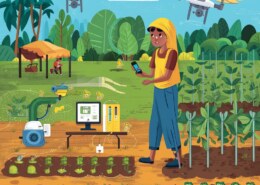What are the present challenges before crop diversification? How do emerging technologies provide an opportunity for crop diversification?
Micro-irrigation, including drip and sprinkler systems, holds significant potential in addressing India's water crisis by improving water use efficiency in agriculture: Water Savings: Micro-irrigation delivers water directly to the roots of plants, minimizing evaporation and runoff compared to tradiRead more
Micro-irrigation, including drip and sprinkler systems, holds significant potential in addressing India’s water crisis by improving water use efficiency in agriculture:
- Water Savings: Micro-irrigation delivers water directly to the roots of plants, minimizing evaporation and runoff compared to traditional flood irrigation. This method can save substantial amounts of water, crucial in water-stressed regions.
- Increased Crop Yield: By providing water and nutrients in a targeted manner, micro-irrigation systems enhance crop growth and yield. This efficiency allows farmers to achieve better economic returns per drop of water used.
- Salinity Management: Controlled application of water through micro-irrigation helps in managing soil salinity levels, crucial in areas where salinization is a concern due to high water table or poor drainage.
- Climate Resilience: As India faces increasingly erratic rainfall patterns due to climate change, micro-irrigation offers flexibility and reliability in water supply, enabling farmers to sustain agriculture even during dry spells.
- Energy Savings: Reduced pumping requirements for micro-irrigation systems compared to traditional methods result in energy savings, contributing to lower operational costs for farmers.
To fully realize these benefits, widespread adoption of micro-irrigation across India’s agricultural landscapes is essential. This requires supportive policies, financial incentives, and capacity building to enable farmers to adopt and effectively manage these technologies, thereby contributing significantly to mitigating the country’s water crisis while improving agricultural productivity and sustainability.
See less

Present Challenges Before Crop Diversification 1. Economic Factors: Market Risks: Uncertain markets for non-traditional crops can deter farmers from diversifying. Income Stability: Traditional crops often have established markets and support systems, providing more predictable income. 2. InfraRead more
Present Challenges Before Crop Diversification
1. Economic Factors:
2. Infrastructure and Logistics:
3. Knowledge and Skills:
4. Policy and Institutional Support:
5. Environmental Concerns:
6. Market Access and Consumer Preferences:
How Emerging Technologies Provide an Opportunity for Crop Diversification
1. Precision Agriculture:
2. Genetic Engineering and Biotechnology:
3. Digital Platforms and Marketplaces:
4. Smart Irrigation Systems:
5. Supply Chain Innovations:
6. Financial Technology (FinTech):
Emerging technologies can thus mitigate the risks and barriers associated with crop diversification, making it a more viable and attractive option for farmers.
See less